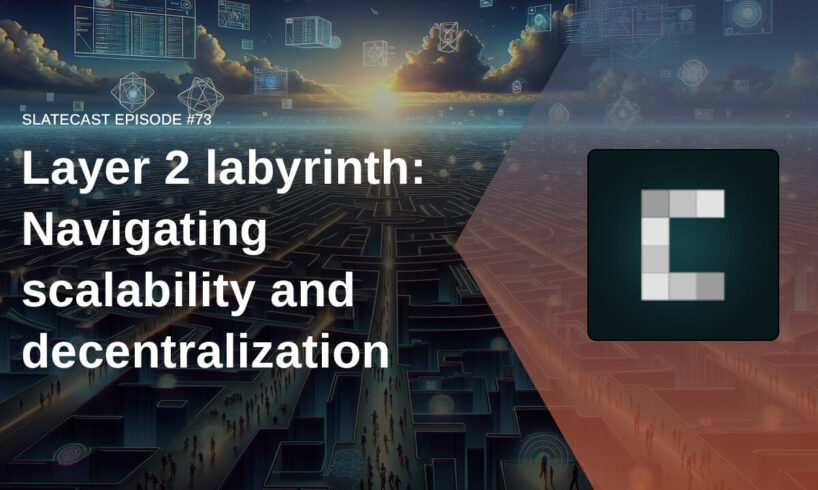
[ad_1]
In the latest episode of the SlateCast, CryptoSlate welcomed Roy Hui, the founder of Pellar and LightLink, to discuss the role of enterprise and permissioned blockchains in the evolving world of Web3. Joined by Senior Editor Liam “Akiba” Wright and CryptoSlate CEO Nate Whitehill, the conversation delved into the unique value proposition of platforms like Pellar and LightLink and how they complement and compete with decentralized solutions like Bitcoin.
The complementary role of alternative blockchains
Hui acknowledged Bitcoin’s primary use as a store of value, but he emphasized the need for alternative technologies to facilitate digital payments and currency transactions. He explained:
“Bitcoin, on the other hand, could represent value, but the medium of exchange needs another technology, and there’s nothing more efficient than a Bitcoin type of blockchain for that digital payment system.”
Hui believes public blockchains offer substantial advantages over traditional databases, including transparency, trust, and finality. He argued that while Bitcoin excels as a store of value, other blockchain solutions are better suited for facilitating efficient and secure digital transactions.
The value of permissioned blockchains
One key discussion centered on the necessity of permissioned blockchains for enterprises and governments. Hui highlighted the diverse spectrum of blockchain solutions, ranging from fully decentralized networks like Ethereum to private databases.
Hui emphasized that enterprises can participate in the broader public blockchain ecosystem or remain siloed, depending on their specific needs and requirements for security and privacy.
Gasless transactions and enterprise adoption
A standout feature of LightLink is its approach to gasless transactions, which Hui believes will foster broader enterprise adoption and user-friendly experiences. He elaborated:
“Enterprise customers pay for gas fees as opposed to a user paying. This model is very well proven in a lot of other Layer 2s as well, using Paymaster as an example. In our case, we’ve architected the blockchain from ground up to achieve a different type of gas mode, where enterprise customers pay in fiat, as opposed to a Bitcoin.”
By removing the unpredictability of gas fees and enabling enterprises to pay a fixed monthly fee, LightLink aims to provide a predictable and accessible infrastructure for businesses to leverage blockchain technology.
Open source and enterprise collaboration
While open-source software and enterprise solutions may seem like contrasting concepts, Roy Hui emphasized that they can coexist and even complement each other. The decision to make LightLink open source was a strategic move to foster transparency and collaboration within the ecosystem. Despite the association of open-source software with decentralization and public access, enterprises can still leverage its benefits while maintaining their desired level of privacy and control.
Hui explained that enterprises have the flexibility to participate in the broader open-source ecosystem or operate within a siloed environment, depending on their specific requirements for security and confidentiality. Open-source platforms like LightLink provide a foundation for innovation, allowing enterprises to build upon and contribute to the codebase while implementing additional layers of encryption, access controls, and privacy measures to meet their unique needs.
By embracing open-source principles, LightLink aims to foster a collaborative environment where enterprises can leverage the collective expertise of the community while retaining the ability to tailor the solution to their specific use cases.
The future of layer 2 solutions
Looking ahead, Hui envisions a future where Layer 2 solutions become increasingly interconnected and efficient, enabling seamless transactions across multiple chains. He anticipates smart routing, messaging, and arbitrage bots facilitating the most efficient transaction pathways, regardless of the underlying Layer 2 network.
As the Web3 ecosystem evolves, the discussion with Roy Hui highlighted the crucial role of enterprise and permissioned blockchains in facilitating real-world adoption and practical use cases. Platforms like Pellar and LightLink offer innovative solutions that bridge the gap between decentralized networks and enterprise requirements, paving the way for a more inclusive and accessible future for blockchain technology.
Watch the full podcast below…
NEW SLATECAST 🎙️ Layer 2 labyrinth: Navigating scalability and decentralization@LightLinkChain founder @royhui discusses the future of enterprise and permissioned blockchains in Web3, emphasizing the value of gasless transactions.
Co-hosted by @NateWhitehill @akibablade pic.twitter.com/hGx6x2Pfio
— CryptoSlate (@CryptoSlate) March 15, 2024
[ad_2]
Source






